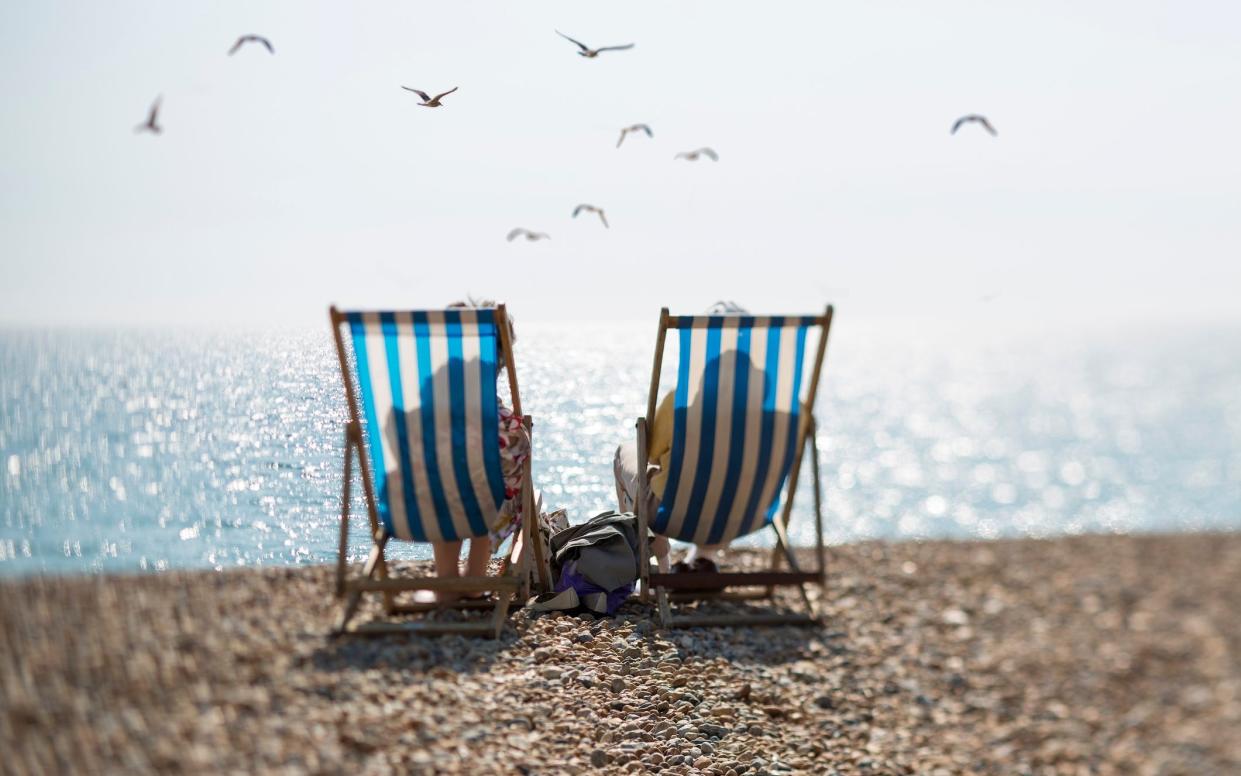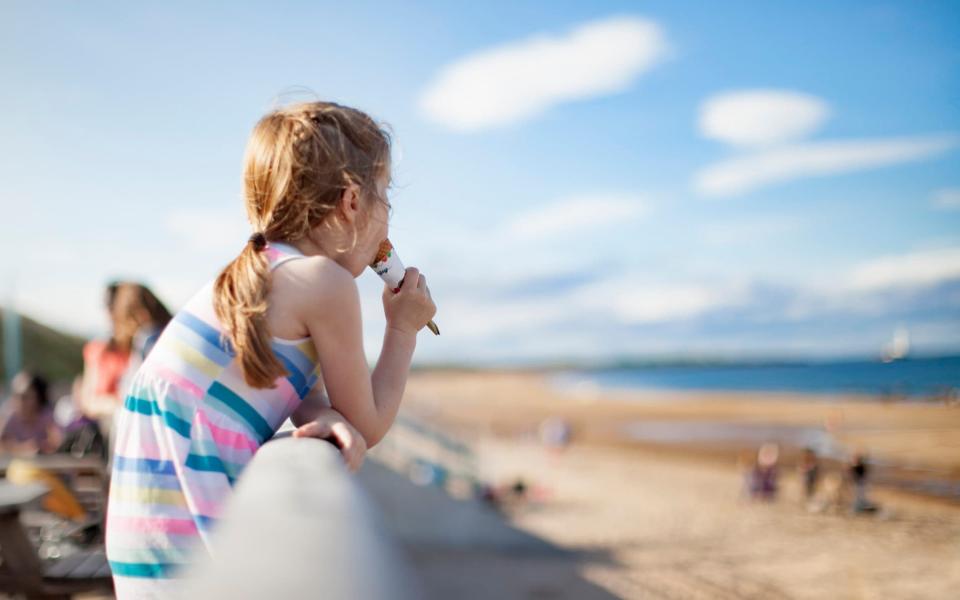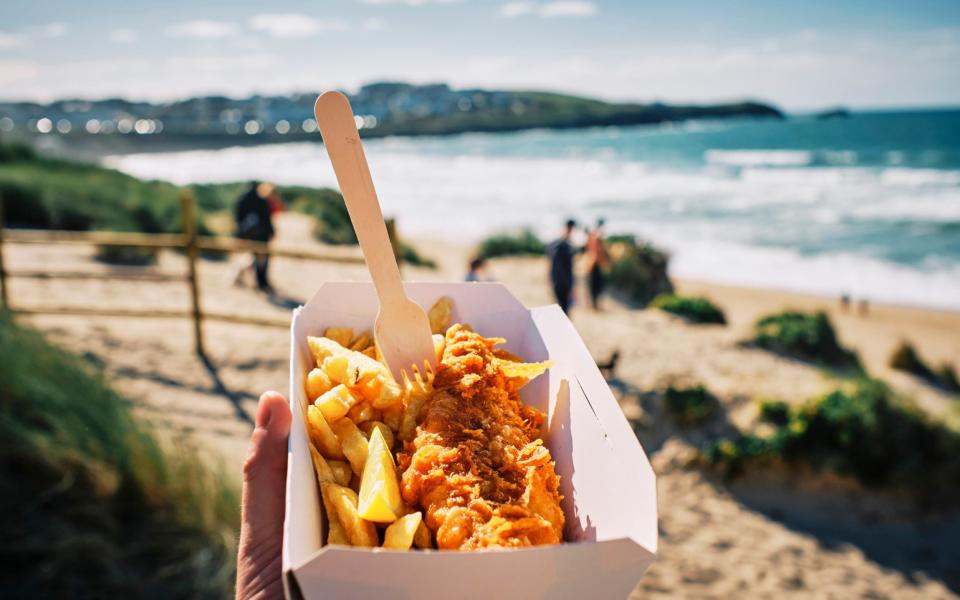The 15 things you need for a perfect UK seaside holiday (and the best places to find them)

What really makes a brilliant beach holiday? Hot sun? White sand? Bath-warm sea? Maybe. But a truly great beach holiday is all about the heart, and British beaches have it in spades.
I remember when my own school holidays stretched beyond infinity and I could think of no words greater than: Great Yarmouth. This coastal frenzy was but 10 miles from my village and, to my child brain, nowhere was better.
There were sand and sea, of course (albeit sludgier than the Med-like postcards would have you believe). But it wasn’t so much the beach. It was the multi-layered smell: salt-sweet, chip fry, horse-and-carriage poo. The penny slots and Derby race machines. The way you could see the waves through the planks of Britannia Pier, where Jim Davidson was always on the theatre bill (and still is, in summer 2022). The hypnotic doughnut machines plopping globs into hot oil that sizzled into sugary deliciousness. The wax works so brilliantly bad you couldn’t tell Sean Connery from Daley Thompson. The wonder of watching the Hippodrome’s circus ring fill with water and synchronised swimmers. The Pleasure Beach’s wooden rollercoaster, which has been scaring riders since 1932 (though, back then I didn’t know it was vintage, just that it felt like it might fall apart).
Like many I grew older and more cynical. Home was naff. Greece and Spain were the cool places to be. But now, older still, I’ve changed my mind again. Unashamed nostalgia seems just the ticket. It’s time to re-embrace the British seaside in all its flavours.
1. Beach huts
The cutesy successor of the bathing machine, the beach hut is just the ticket if you want to maintain your modesty when changing into your swimmers, or simply boil a brew right by the sand. They come in various hues – bright, weather-worn, nautical – and various levels of crazy: last year, a shack on Dorset’s Mudeford Spit went on sale for £575,000.
Best of British: Abersoch, Gwynedd
There’s something extremely pleasing about the higgle-piggle huts backing Abersoch’s Blue-Flagged sand. Hiring one (from £400pw) gives immediate access to this lovely Llyn Peninsula beach, with its sheltered swimming and Snowdonia views. Take a paddleboarding lesson (from £35pp; abersochwatersports.co.uk) to view the huts from water level. For ideas on where to stay, read our complete guide to the best hotels in Gwynedd.

2. Postcards
Forget photos of local landmarks. From the 1930s, postcards took a turn for the Carry On: cartoons of Buxom lasses, bare buttocks, stick-of-rock innuendos and fellas fnarr-fnarring over impossible cleavages. At their peak, 16 million a year were sold. PC? Perhaps not. British? Very.
Best of British: Ryde, Isle of Wight
Queen Victoria was a huge fan of Ryde, although whether she would have been amused by Donald McGill’s suggestive scribbles is unknown. From the 1940s to the 1960s, McGill was king of the saucy seaside postcard. His works – including some once banned in the 1950s under the Obscene Publications Act – are displayed at the Donald McGill Museum (entry £3; saucyseasidepostcards.com). Take a cheeky peek then walk to the seafront and along Ryde Pier – opened in 1814, it’s the oldest pleasure pier in the world. For ideas on where to stay, read our complete guide to the best hotels in the Isle of Wight.
3. Ice cream
Whether it’s a soft-whipped 99 from a pastel-hued van or a velvety-thick boule, churned from local cows, there’s nothing better than a cool cone on a hot day. The ergonomics of the waffle, the heady hit of the first lick, the race to chase melting dribbles down your fingers... Sweet seaside perfection.
Best of British: Largs, Ayrshire
When the good people of Glasgow want ice cream, they’ll likely aim for Largs. Nardini’s has served gelato in this Firth of Clyde-side town since 1935; at its art-deco parlour you can pick from 32 flavours or order a 12-scoop Clyde Coast Extravaganza (£14.95; nardinis.co.uk). Largs is also a port of call for the Waverley, the world’s last sea-going paddlesteamer – hop aboard for trips to Arran and the Kyles of Bute (from £26pp; waverleyexcursions.co.uk).

4. Piers
First built so posher passengers could disembark from steamships without getting their crinolines wet, piers soon became places to perambulate in their own right. Between 1814 and 1905, 100 overwater walkways were constructed across Britain (many charging tolls to keep the rabble away). Today, 59 remain, ranging from elegant to candy-floss fun.
Best of British: Llandudno, Conwy
The longest in Wales, Llandudno’s Victorian pier (open until 10pm daily; llandudnopier.com) was runner-up in the 2021 Pier of the Year awards. It’s a 700m-long nostalgia trip of sweet shops and penny slots, where you can devour doughnuts, consult the Zoltar fortune-telling machine and catch live entertainment in the pier bar; dolphins are occasionally spotted off the end, too.

5. Sand castles
British tourists have been making sand castles since at least the 19th century. But don’t get blasé with your moats and mottes – there’s serious science to it. Following several experiments, the Paris Laboratory of Physical Statistics concluded that compaction is key, hands are better than spades and the ideal ratio is one part water to 99 parts dry sand.
Best of British: Weymouth, Dorset
Weymouth is the birthplace of British sand sculpture and home of Sandworld, where you can watch masters from around the globe carving brilliant beach art; this year’s theme is Around the World (£7.95/5.95 adult/child; sandworld.co.uk). The town’s Blue Flag beach is the place to practice making your own. When you’re done, head for Catch, a sea-to-plate restaurant above the Old Fish Market (two-course dinner £50pp; catchattheoldfishmarket.com). For ideas on where to stay, see our complete guide to the best hotels in Dorset.
6. Fish & chips
Salt and vinegar? Mushy peas? Curry sauce, tartare or gravy? A sprinkling of scraps? No matter your preference, we can all agree: there’s nothing like eating fish and chips by the sea, right out of the wrapping, while fending off gulls with a tiny wooden fork. Fancy frites and fritto misto have their place – but it’s not here.
Best of British: Whitley Bay, Tyne & Wear
National Fish & Chip Awards 2020 Restaurant of the Year went to Trenchers, an outpost of the award-winning Whitby outfit that sits under the white dome of Whitley Bay’s 1920s-built Spanish City; a pianist might even be tinkling while you eat (cod & chips from £12.95; spanishcity.co.uk/trenchers-fish-chips). Before indulging, walk past the town’s Victorian terraces and beloved Di Meo’s ice-cream parlour to St Mary’s lighthouse, climbing the 137 steps for the best views.

7. Rockpooling
The sea is almost as mysterious as outer space, and delving about in rockpools almost as exotic as a mission to Mars. Poke about and you’ll find a new cast of aliens, replenished with every tide, from tentacle-y anemones to common blennies – a fish that can walk on land.
Best of British: Runswick Bay, North Yorkshire
There’s not a lot that isn’t great about ravishing Runswick Bay: the cliff-tumbling village, the bobbing boats, the soft-blonde sand. Either side of the bay are rockpools that reveal a wonderland of barnacles, limpets, hermit crabs, periwinkles, starfish and sea slugs. The geology of this coastline also means fossils might be found, or even a piece of Whitby jet. You can download rockpooling factsheets (ywt.org.uk) or try out a beachcombing session (£15/£10 adult/child; hiddenhorizons.co.uk).
8. Crabbing
Crabbing is fishing for non-fishers: none of the skill, all the thrill as you wait for the tell-tale tug. Just be sure to bait your line well (crabs like bacon) and don’t put too many in one bucket, to avoid any fisti-claws.
Best of British: Wells-next-the-Sea, Norfolk
While Cromer, around the coast, is the country’s crab capital – renowned for its sweet-tasting crustaceans – Wells is the place for “gillying”. The centuries-old harbour is teeming with the critters; hire reusable kit from the Gilly Hut (£6, £5 refunded on return; wellsguide.com), drop a line off the sea wall and see... No luck? Order one freshly dressed at the Wells Crabhouse (crab platter from £26; wellscrabhouse.co.uk). Then take a long walk on the immense beach – at low tide, it’s a mile to the water’s edge. For ideas on where to stay, see our complete guide to the best hotels in Norfolk.

9. Donkey rides
First donkeys carted cockles along the British coast. Then, as tourism flourished, they carted them too. Conditions weren’t great, though Blackpool’s 1942 Donkey Charter brought improvements (licences required, plump riders banned). Today, several resorts still offer rides, though do check animal welfare standards first.
Best of British: Seacliff, East Lothian
If you have concerns, opt for a different beast. At spectacular Seacliff Beach you can hack out on trustworthy horses; rides cross the red-yellow sand, with views to two ruined castles and gannet-flocked Bass Rock (one-hour rides £45/£35 adult/child; seacliffstables.co.uk). Dismount and head to nearby North Berwick, where the Lobster Shack cooks up the freshest local catch (fish and chips £11.40; lobstershack.co.uk).
10. Model villages
The world’s oldest – Bekonscot – might be in Buckinghamshire, but model villages seem at home beside the sea, slotting neatly into the pantheon of coastal eccentricities that also includes the likes of shell grottoes, wax works and big plastic things. Plus Gullivering around tiny towns of mini weddings, hospitals and Taj Mahals is satisfying indeed.
Best of British: Babbacombe, Devon
Babbacombe’s model village (from £14.50/£11.50 adult/child; model-village.co.uk), with its shrunken Stonehenge, Tudor houses, Travel Lodge and population of 13,178 little people, has been delighting holidaymakers since 1963. From the village, walk to the top station of the vintage Cliff Railway, which has been easing access to shingly Oddicombe Beach for nearly a century (from £2.20; babbacombecliffrailway.co.uk). For ideas on where to stay, see our complete guide to the best hotels in Devon.
11. Winter gardens
Those canny Victorians. With Britain lacking the weather to guarantee outside seaside fun, they catered for fun inside as well: ballrooms, pleasure domes and winter gardens, where tourists could be entertained in all seasons. Many haven’t survived, but some beauties – just about – remain.
Best of British: Morecambe, Lancashire
The Winter Gardens (tours £10; morecambewintergardens.co.uk) has lorded over Morecambe’s prom since 1897; everyone from Elgar to the Who has played here. The Grade II-listed building is now run by a preservation trust, seeking to restore the concert hall to its former glory. Behind-the-scenes tours reveal its mosaic floors and precipitous Upper Circle. For ideas on where to stay, see our complete guide to the best hotels in Lancashire.

12. Swimming
It’s not truly a British beach holiday if you don’t dip at least a toe in the sea. Brave enough for a proper swim? Yes, our waves are chilly – but that’s a sadistic part of the appeal. If your skin isn’t blotched red and goosebumped you haven’t really put the effort in.
Best of British: Harris & Lewis, Hebrides
The Hebrides have some of the country’s best beaches. Luskentyre, Seilebost, Huisnis... all are white-sand, turquoise-sea slivers offering excellent – if briskly invigorating – swimming. Actually, thanks to the Gulf Stream, water temperatures are sometimes the same here as in Cornwall. Plus you might get to share your dip with a few locals: seals, otters, curlews and kittiwakes may be seen. Try a beginners wild swim experience (from £20pp; immersehebrides.com). For ideas on where to stay, see our complete guide to the best hotels in the Highlands.
13. Gulls
While these big, beady-eyed scavengers can be a menace, nothing transports you to the coast like their mewling call. It’s the love-hate soundtrack of the seaside: unpleasantly piercing but essential. Just keep an eye on your chips...
Best of British: Bridlington, East Yorkshire
Gulls may be common, but, still, the sight of thousands of them and their feathered brethren is up there with the best wildlife spectacles. Sail from Bridlington aboard the MV Yorkshire Belle (£20/£10 adult/child; yorkshire-belle.co.uk) for a better look at the half-a-million-odd seabirds – gannets, kittiwakes, guillemots, puffins – that gather on RSPB Bempton Cliffs. Back in Bridlington, grab a royally-approved haddock supper at Fish & Chips 149 (Best National Takeaway, Fish & Chip Awards 2011) – the Duchess of Cornwall declared them “delicious” (149fishandchips.co.uk). For ideas on where to stay, see our complete guide to the best hotels in North Yorkshire.

14. Seaside walks
Whether you’re promenading under blue skies or bent-over braced against a hoolie, there’s no more classic British seaside activity than going for a stroll. Tramping across clifftops, crunching on shingle, sashaying along elegant esplanades – any walk will do, so long as it gets salt-spray up your nostrils and worries blown away.
Best of British: Whitehaven, Cumbria
The stretch between the Georgian port of Whitehaven and the Lake District village of Silecroft, part of the England Coast Path (nationaltrail.co.uk), features high cliffs, RSPB sites, beach huts and Hadrian’s Wall. Before you set off, visit Whitehaven’s Rum Story, where tales of smuggling and the slave trade are retold in the town’s original warehouses and cellars (from £9.95/£4.95 adult/child; rumstory.co.uk). For ideas on where to stay, see our complete guide to the best hotels in Cumbria.
15. Funiculars
The Victorians popularised many things, among them beach holidays and railways. The cliff-scaling funicular marries both, showing off a superlative grasp of engineering and a keenness to tame the coast. And who doesn’t love gliding uphill in a tiny carriage, effortlessly gaining a gull’s eye view?
Best of British: Hastings, East Sussex
There are 13 cliff railways pootling up-down the UK’s edges. Hastings has two: its water-balanced East Hill Lift (from £2.60; visit1066country.com), which links the town’s fishing quarter and Country Park, is the country’s steepest; West Hill Lift, running from George Street to the ruins of Hastings Castle, still uses its original 19th-century carriages.
What do you love most about UK beach holidays? Which places off the most authentic experience? Please leave your comments below.


